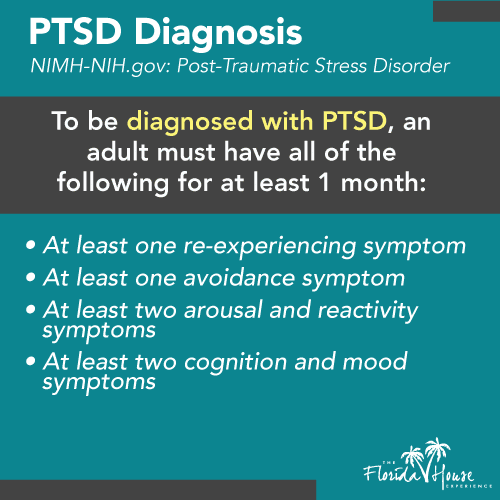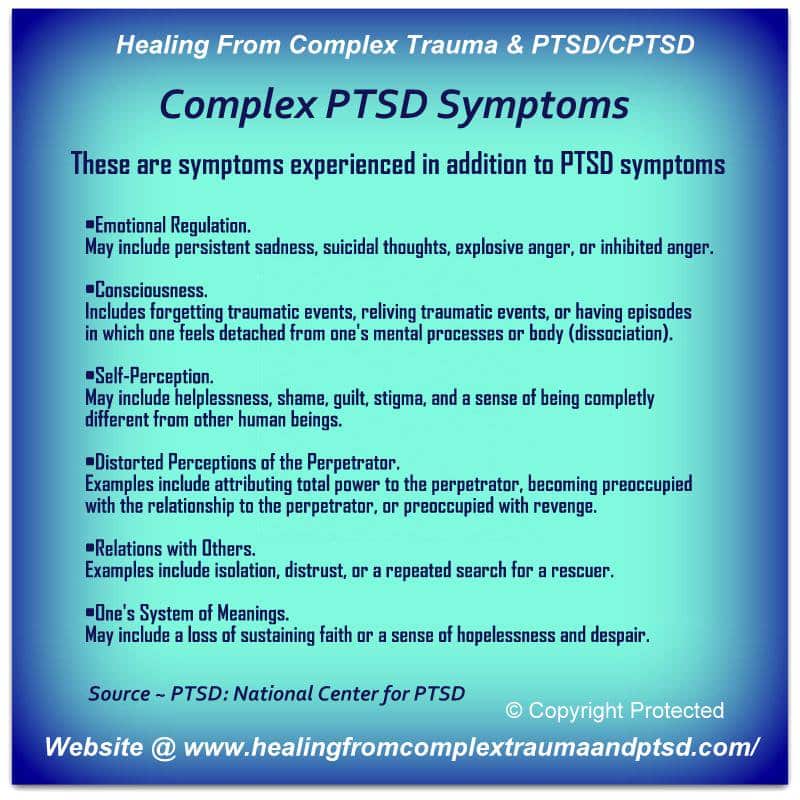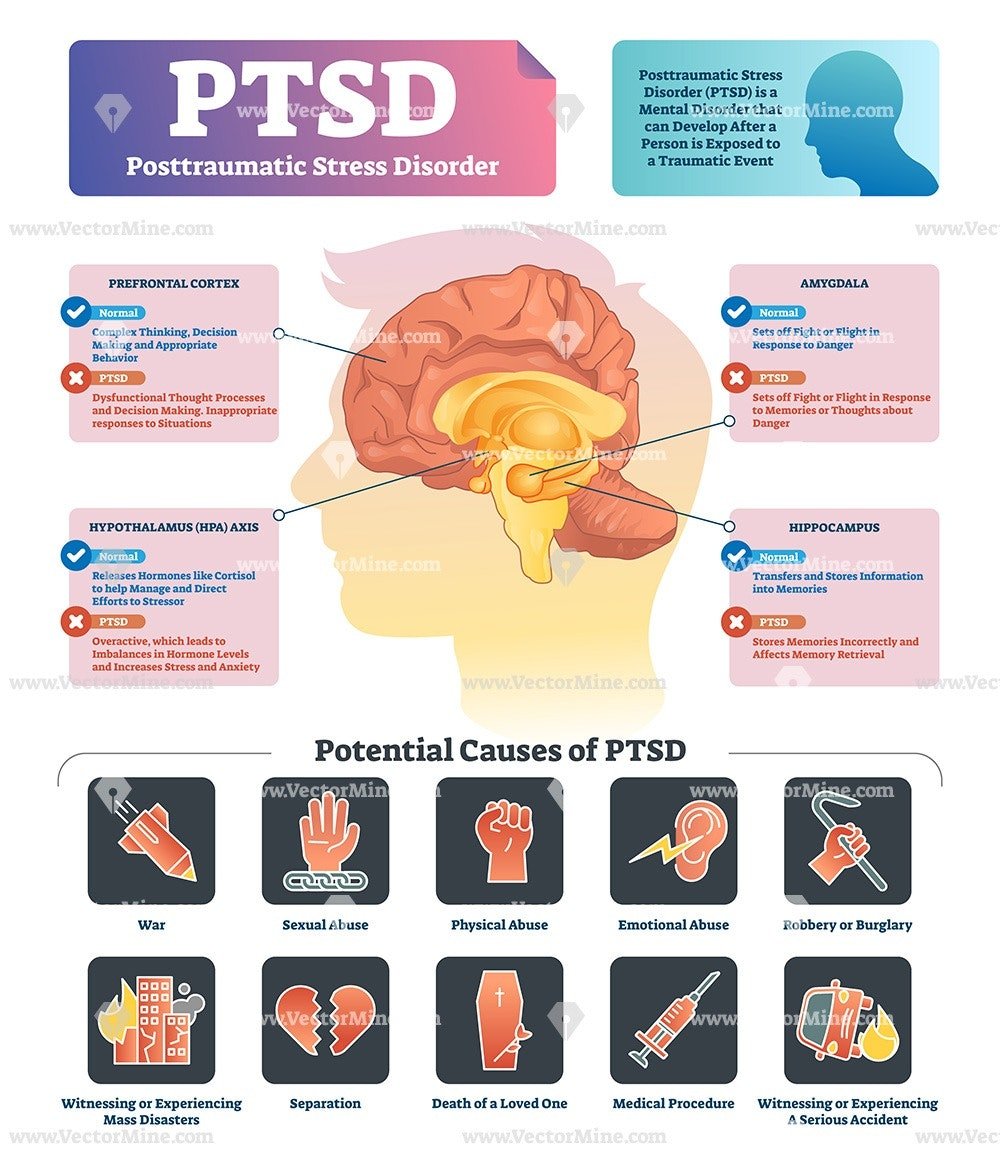What Are The Treatments For Post
The main treatments for PTSD are talk therapy, medicines, or both. PTSD affects people differently, so a treatment that works for one person may not work for another. If you have PTSD, you need to work with a mental health professional to find the best treatment for your symptoms.:
- Talk therapy, or psychotherapy, which can teach you about your symptoms. You will learn how to identify what triggers them and how to manage them. There are different types of talk therapy for PTSD.
- Medicines can help with the symptoms of PTSD. Antidepressants may help control symptoms such as sadness, worry, anger, and feeling numb inside. Other medicines can help with sleep problems and nightmares.
What Happens When Youre Diagnosed With Ptsd During Active Duty
Many soldiers experience post-traumatic stress disorder while on active duty but may not realize theyre suffering from this medical condition. After witnessing or being involved in a traumatic, life-altering event, some military personnel might not understand the changes in their personal behavior or be able to cope with the nightmares and flashbacks that often follow a traumatic incident and resort to substance abuse to cope.
If youre a soldier on active military duty and believe you may have PTSD, its important to seek treatment for it while youre in service.
How Is Ptsd Diagnosed
Though it may seem difficult to know how to diagnose PTSD, rest assured that there is a system in place. The Diagnostic and Statistical Manual of Mental Disorders details the specific requirements that must be met before getting diagnosed with PTSD is possible.
As outlined in the DSM-5, 8 criteria are considered to make a PTSD diagnosis. The following is an overview of those clinical standards.
You May Like: How Long Do Long Term Disability Benefits Last
Eye Movement Desensitization And Reprocessing
EMDR is commonly used to treat PTSD, and it can be helpful for CPTSD as well. Youll be asked to briefly think about a traumatic moment while moving your eyes from side to side. Other techniques include having someone tap on your hands instead of moving your eyes. Over time, this process may help to desensitize you to traumatic memories and thoughts.
While theres some debate within the medical community over its use, the American Psychological Association conditionally recommends it for PTSD. This means that they recommend it but additional information is still needed due to insufficient evidence.
Arousal And Reactivity Symptoms Include:

- Being easily startled
- Feeling tense or on edge
- Having difficulty sleeping
- Having angry outbursts
Arousal symptoms are usually constant, instead of being triggered by things that remind one of the traumatic events. These symptoms can make the person feel stressed and angry. They may make it hard to do daily tasks, such as sleeping, eating, or concentrating.
Recommended Reading: How To Calculate Multiple Va Disability Ratings
How A Ptsd Diagnosis Will Affect Your Military Career
While many men and women in service may believe that being diagnosed with PTSD can end their careers, the truth is that, in some cases, seeking help may actually protect them. If you seek medical care and get treatment instead of letting your PTSD develop into poor conduct problems and other serious issues, it can be viewed that you took positive steps to address your symptoms.
Additionally, some soldiers believe theyll lose their security clearance if theyre diagnosed with PTSD, and this isnt true. Because you sought help for your symptoms, it also may be seen as positive action and could allow for the continuation of your security clearance.
Its true that theres been a stigma in the military about PTSD, and personnel have been reluctant to admit when they have symptoms of this medical condition. However, the stigma is decreasing, and active duty military members are beginning to understand they have a right not to be penalized for behavior or actions that are a result of their PTSD.
Talk To Someone You Trust
After a traumatic event, it’s normal to think, act, and feel differently than usual. Most people will start to feel better after a few weeks. If your symptoms last longer than a few months, are very upsetting, and disrupt your daily life, you should get help. Whether or not you have PTSD, treatment can help if thoughts and feelings from the trauma are bothering you. Talk to:
- Talk to your family doctor.
- A mental health professional, such as a therapist.
- Your local VA facility or Vet Center, if you are a Veteran
- A close friend or family member who can support you while finding help
- A clergy member
- Fill out a PTSD questionnaire or screen .
Don’t Miss: Can You Work While On Disability In Michigan
When To See A Professional
The debilitating symptoms of PTSD can make living, working, and interacting difficult. In fact, many people struggling with post traumatic stress disorder can turn to unhealthy coping skills like substance abuse or self-harm in an attempt to minimize or escape from their emotional distress.
If you have been experiencing symptoms for longer than a month, it could be helpful for you to talk with a professional. When you are dealing with nightmares, flashbacks, and a negative outlook about yourself and others, it can begin to feel like things will never change.
Finding a qualified professional to help can make all the difference, bringing back hope through the sharing of your experiences and helping you learn healthy, effective ways of coping.
PTSD Discussion Guide
Ptsd Checklist For Dsm
Patients can also use the PTSD Checklist for DSM-5, or PCL-5, to assess their symptoms. Composed of 20 questions, this report was created by the National Center for PTSD of the Department of Veterans Affairs and is used widely because it can offer support throughout a persons PTSD journey.
In addition to supporting self-assessment with PTSD, it can also be used after a diagnosis to monitor symptoms. Therefore, it acts both as a tool for diagnosis and one for assessing symptoms to understand improvement.
You May Like: Can You Get Unemployment And Disability
Ptsd Symptom Scale Interview
The PSS-I is a 17-item assessment tool that asks patients to identify a singular traumatic event that they believe is causing their symptoms. Symptoms from the past two weeks are identified and assessed as they relate to the DSM-5 diagnosis criteria.
The PSS-I-5 contains 24 questions, with 20 focusing on symptoms and four focusing on symptom distress, interference, onset, and duration.
About Post Traumatic Stress Disorder
As stated above, Post Traumatic Stress Disorder once known as shell shock or battle fatigue syndrome, is a serious mental disorder that develops after an individual experiences or witnesses a horrific event. PTSD is the lasting repercussion of a traumatic experience in which serious physical and/or mental harm occurred. Such events include war combat, sexual abuse, natural disasters, witnessing a murder etc.
It is good to keep in mind that most people experience a traumatic event during their lifetime that can cause shock, fear, or guilt. However, this does not mean they have PTSD as these reactions are normal and will go away with time. It is much different for someone with PTSD because the feelings do not go away and actually tend to get much worse. The symptoms can become so bad that it interferes with a persons activities of daily living and occupation.
The symptoms of PTSD are grouped into three categories:
Intrusive or Re-experiencing Symptoms:
- Reoccurring, undesired memories of the horrific event
- Flashbacks or reliving the event as though it was happening again
- Nightmares and disturbing dreams about the event
- Emotional and physical distress to anything that reminds the person of the event
Avoidance Symptoms:
- Individual attempts to avoid talking or thinking about the event
- Individual avoids people, places and activities that remind them of the event
- Detachment and isolation from friends and family
Hyper-arousal Symptoms:
Recommended Reading: What States Have Property Tax Exemptions For Disabled Veterans
How Can Parents Help
If your child has been through trauma, here are things you can do:
- Help your child feel safe. They may need extra time, comfort, and care from you for a while.
- Help your child relax. Invite them to take a few slow breaths with you. Breathe in while you count to 3. Breathe out while you count to 5.
- Do things together that you enjoy. Trauma can make it harder to feel the positive emotions that naturally help kids recharge. Play, laugh, enjoy nature, make music or art, cook. These activities can reduce stress and build your childs resilience.
- Reassure your child. Let them know they will get through this. And that you are there to help.
- Let your childs doctor know what your child has been through. Get a referral to a mental health professional .
- Tell your childs teacher that your child went through a trauma. Kids with PTSD may have more trouble focusing on schoolwork. Ask for your child to have extra help or more time to do schoolwork if they need it for a while.
What Is Posttraumatic Stress Disorder

Posttraumatic stress disorder is a psychiatric disorder that may occur in people who have experienced or witnessed a traumatic event such as a natural disaster, a serious accident, a terrorist act, war/combat, or rape or who have been threatened with death, sexual violence or serious injury.
PTSD has been known by many names in the past, such as shell shock during the years of World War I and combat fatigue after World War II, but PTSD does not just happen to combat veterans. PTSD can occur in all people, of any ethnicity, nationality or culture, and at any age. PTSD affects approximately 3.5 percent of U.S. adults every year, and an estimated one in 11 people will be diagnosed with PTSD in their lifetime. Women are twice as likely as men to have PTSD. Three ethnic groups U.S. Latinos, African Americans, and American Indians are disproportionately affected and have higher rates of PTSD than non-Latino whites.
People with PTSD have intense, disturbing thoughts and feelings related to their experience that last long after the traumatic event has ended. They may relive the event through flashbacks or nightmares they may feel sadness, fear or anger and they may feel detached or estranged from other people. People with PTSD may avoid situations or people that remind them of the traumatic event, and they may have strong negative reactions to something as ordinary as a loud noise or an accidental touch.
Recommended Reading: How Much Does Permanent Disability Pay In California
Treatment Options For Ptsd
Not everyone develops PTSD after experiencing a traumatic event, but if you do, getting help and support from loved ones and a healthcare professional is key to recovery.
Often, a combination of medication and psychotherapy is recommended . If you feel that your symptoms are interfering with your ability to function, contact a mental health professional.
Call the Substance Abuse and Mental Health Services Administration at 1-800-662-HELP for 24/7 confidential support and referral for PTSD treatment near you.
Substance Use Or Substance Abuse To Relieve Symptoms
Most people believe that post-traumatic stress disorder only affects those who see or experience a traumatic event first-hand. However, just hearing about traumatic events that happen to those we love may trigger symptoms as well. Another common misconception is that trauma only happens suddenly or in a single event. Unfortunately, repeated exposure to trauma over time can lead to a trauma disorder as well. We often see this with first responders, police officers, and people who have been victimized by sexual or domestic abuse.
Traumatic events are hard to define. Everyone has their own interpretation of their triggers and unique tolerance to stressful events. However, traumatic events can include :
- Natural disasters
Read Also: Veterans United Home Loans Rates
When To Seek A Ptsd Diagnosis
Before a PTSD diagnosis can be considered, an individual must have these cluster symptoms for over one month: recreating the traumatic event over and over avoiding triggering people, places, or activities and hyper-vigilance for danger. These symptoms should cause significant problems in everyday life.
An individual should seek a PTSD diagnosis if these conditions are present in their life, even if it has been several months or even years since a significant trauma, as PTSD symptoms can sometimes take that long to appear.
Understand that every person reacts to trauma differently. While some individuals bounce back after trauma, others need extra support and treatment to be able to heal mentally and emotionally from trauma.
How Do Clinicians Diagnose Ptsd
The process of diagnosing PTSD is fairly straightforward for most people. A number of medical professionals, collectively called clinicians, can determine if someone meets the criteria. Primary care doctors, psychiatrists, clinical psychologists, and clinical mental health counselors are usually those who decide if someone is diagnosed with PTSD. Diagnosis usually happens in one of two ways. Either a person suspects they have PTSD and seeks confirmation from a professional, or changes in their mental health and personality leave them searching for an answer as to what may be going on. At this point, the person is likely to seek out a therapist, doctor, or other mental health provider to diagnose PTSD.
Most health conditions are discovered through “biological markers.” Biological markers are the things we look for in or on the body to confirm disease. For example, if a doctor suspects their patient is suffering from a certain type of blood cancer, they can perform blood testing and bone marrow biopsies to confirm their suspicions. Unfortunately, PTSD does not have any biological markers. A diagnosis can only be made based on a person’s self-reported symptoms, conversations with a family member or loved one about the persons mood symptoms, and their clinician’s ability to rule out other possible mental health conditions or mental illness.
Don’t Miss: Is Stuttering A Disability Under The Ada
Short Ptsd Rating Interview
The Short PTSD Rating Interview, or SPRINT, can be used to assess main PTSD symptoms. It looks at eight proven PTSD symptom categories, including intrusion, avoidance, numbing, arousal, somatic malaise, stress vulnerability, and role and social impairment.
This assessment is best used when a person is first interested in seeking care for PTSD, and it is considered a more preliminary approach for people who arent sure whether they have PTSD. The test uses a five-point scale, asking patients to rank their symptoms from 0 to 4. If a persons results are positive, meaning they rated at least one question above 0, they need further assessment by a professional.
Does Trauma Always Cause Ptsd
No. Going through trauma does not always cause PTSD. Most kids and teens who go through a trauma will not get PTSD.
But most of them will feel the effects of trauma. Its normal to react to a deeply stressful event. Most will have upset feelings, thoughts of the trauma, and other signs of distress. This may last for a short while, sometimes days or weeks. With comfort, listening, and support, most can find ways to cope with what theyve been through.
PTSD develops when a trauma overwhelms a childs ability to cope. Kids and teens with PTSD need extra help to move through the coping process.
Things that affect whether someone develops PTSD after a trauma include:
- how severe the trauma was
- how quickly they get help and support
- a past history of trauma
- inherited risks like family history of depression and anxiety
Read Also: Can Your Employer Contact You While On Short Term Disability
How A Professional Comes To A Ptsd Diagnosis
According to PTSD United, roughly 24.4 million Americans have symptoms of PTSD. Despite its prevalence, the condition is still somewhat misunderstood, and many people try to cope with their symptoms alone. Seeking a diagnosis for PTSD is important for many reasons including getting much-needed PTSD treatment. Maybe youre wondering, how can a therapist diagnose PTSD? Mental health professionals have a few key resources they can use to help a patient get diagnosed and learn about treatment options. If you suspect that you or a loved one are dealing with PTSD, but aren’t quite sure, consider what we know about the disorder so far and how a trip to your provider can clear up your questions.
Criterion D: Negative Alterations In Mood

Negative alterations in cognition and mood that began or worsened after the traumatic event as evidenced by two or more of the following:
- Inability to recall key features of the traumatic event. This is usually dissociative amnesia, not due to head injury, alcohol, or drugs.
- Persistent, and often distorted negative beliefs and expectations about oneself or the world, such as “I am bad,” or “The world is completely dangerous.”
- Persistent distorted blame of self or others for causing the traumatic event or for the resulting consequences.
- Persistent negative emotions, including fear, horror, anger, guilt, or shame.
- Feeling alienated, detached or estranged from others.
- Persistent inability to experience positive emotions, such as happiness, love, and joy.
Read Also: Ptsd Affects What Part Of The Brain
Criterion B: Intrusion Symptoms
The traumatic event is persistently re-experienced in one or more of the following ways:
- Recurrent, involuntary, and intrusive memories. Children older than six may express this symptom through repetitive play in which aspects of the trauma are expressed.
- Traumatic nightmares or upsetting dreams with content related to the event. Children may have frightening dreams without content related to the trauma.
- Dissociative reactions, such as flashbacks, in which it feels like the experience is happening again. These may occur on a continuum ranging from brief episodes to complete loss of awareness. Children may re-enact the events in play.
- Intense or prolonged distress after exposure to traumatic reminders.
